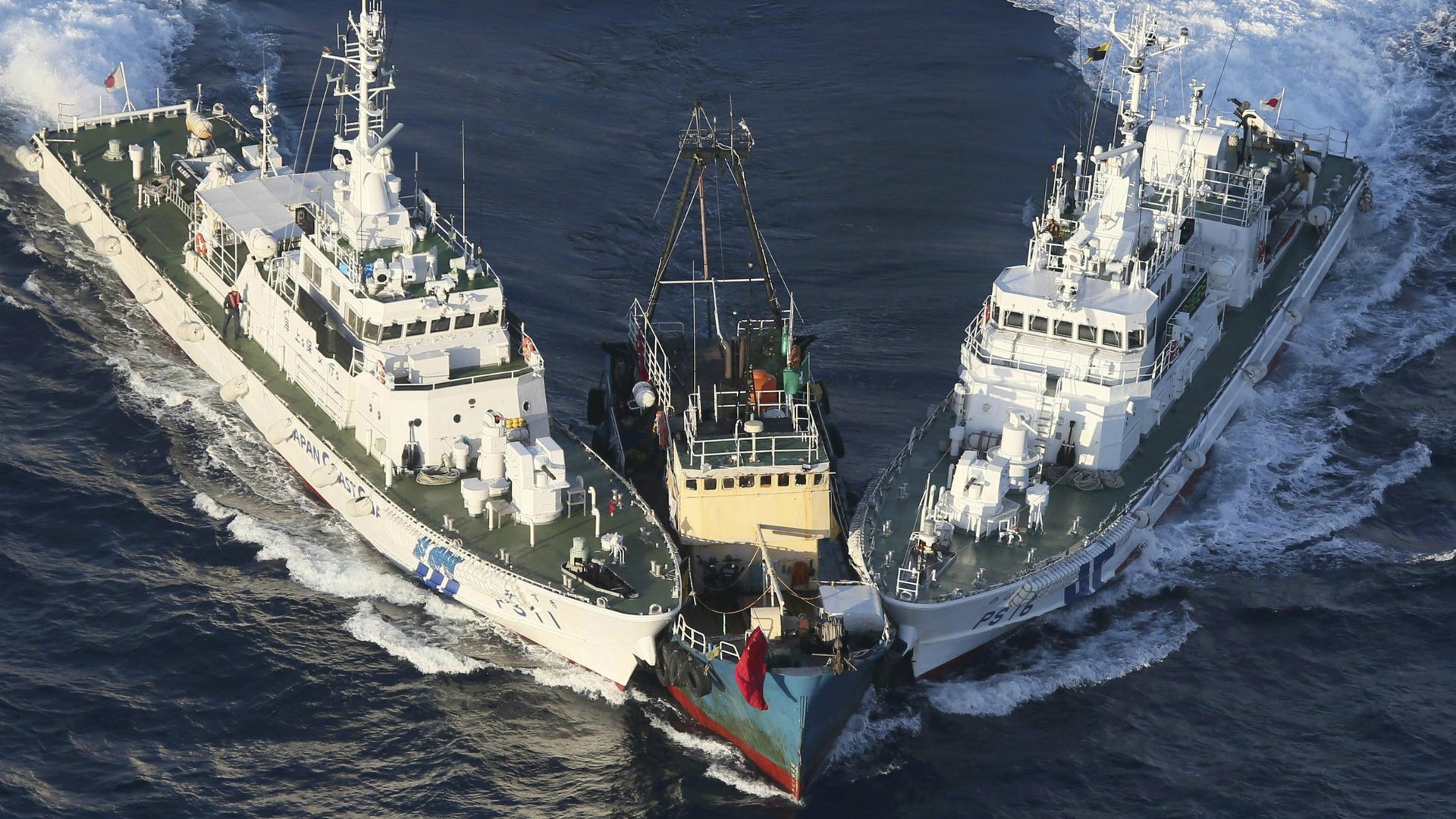These tiny islands, reefs, and shoals are driving much of Asia to the brink of war
Barely a week passes without a tense incident in the disputed waters of the South and East China Seas: A Philippine naval ship shooting up a Taiwanese fishing boat, Chinese patrols edging closer to islands claimed by Japan—even diplomatically provocative cruise ship outings.


Barely a week passes without a tense incident in the disputed waters of the South and East China Seas: A Philippine naval ship shooting up a Taiwanese fishing boat, Chinese patrols edging closer to islands claimed by Japan—even diplomatically provocative cruise ship outings.
At least eight nations claim territory in the region, and tensions have continued to escalate as fisherman expand into new waters and countries eye up the potential for oil and gas deposits.
China has made a broad claim over around 90% of the 3.5 million square kilometer area, and has pushed for one-on-one talks with its neighbors, rather than a regional solution—the preferred solution of the United States, which is allied with many of the claimants and is making a heralded “pivot” to boost its presence in the region. ASEAN, the regional group of Southeast Asia governments, has thus far failed to resolve much of anything.
It’s clear nobody wants war, but plenty of experts say it is possible. Here is a brief compendium of the miniscule land, reefs, shoals, and stretches of open water that have much of Asia on edge.
1)
The Senkaku / Diaoyu Islands
- The five tiny uninhabited islands known to Japan as Senkaku and China as Diaoyu could fit into Manhattan a dozen times over. Both countries alongside Taiwan claim the territory, which has strategic significance due to its proximity to shipping lanes, fish shoals and–potentially–natural resources.
- Claims go back hundreds of years and center on everything from the islands’ discovery, the location of oceanic trenches, and American control of the islands after the Second World War. Japan has current de facto control.
- Japan and China clashed over the islands in September 2012 when the Japanese government bought them from their private owner, leading to destructive anti-Japanese protests all over China and billions of dollars in lost Japanese exports. Periodic flare-ups have occured ever since, most recently in April over a group of Japanese protestors who threatened to land on the islands.
- Tension is still high. On Thursday Japanese media reported that three Chinese government ships had again entered waters around the islands. Taiwan has been much less assertive over its claim, but recently agreed fishing access with Japan, to China’s consternation.
2)
Open Water
- With so many nations competing for dominance of the same sea, it is unsurprising that chance encounters in any stretch of water can escalate quickly. One such dispute between Taiwan and the Philippines led to the death of a Taiwanese fisherman this month. It took place around a small scattering of islands and reefs between the two countries. Taiwan responded by patrolling the sea with a destroyer and fighter jets, demanding an apology (which it then rejected) and imposing sanctions on the Philippines.
3) Spratly Islands
- The Spratlys, known by different names depending on which country you ask, are a collection of hundreds of islets and reefs set between the Philippines, Malaysia and Vietnam. Those three countries, plus China, Taiwan and Brunei, all control some territory, and Taiwan operates a military base in the area.
- The archipelago, which covers over 400,000 square kilometres, is home to rich fishing territory and holds unknown quantities of oil and natural gas deposits that some estimates put in the billions of tons.
- Tension around the islets, which is mostly between Southeast Asian countries and China, has remained low, although on Tuesday the Philippines denounced the “provocative and illegal presence” of Chinese ships which had appeared in the area.
- For the most part, Southeast Asian countries have stood together against China, although Cambodia took China’s side at a regional diplomatic summit it chaired last year, which was the only one since 1967 that did not end with a customary joint statement. Japan recently announced that it would lend the Philippines patrol boats to counter what they see as China’s expansion, which is likely to be welcome given that Filipino marines are defending the Spratly Islands from the deliberately wrecked remains of a World War II boat on one of the remote reefs.
4) Paracel Islands
- Since a battle between Vietnamese and Chinese forces in 1974, the 130-island Paracel archipelago has been held by China. Vietnam still claims some territory along with Taiwan. The island chain is thought to have the potential for oil and gas exploration and is a good source of commercial fishing.
- The islands have been peaceful while under Chinese rule, although in 2012 the Vietnamese government declared the Paracels and Spratlys to be part of its territory. China responded by building a brand new city called Sansha, and started operating commercial tours to the area in April this year.
5) Scarborough Shoal
- The Philippines and China, who fell out over a fishing boat in April last year, only abandoned a two-month standoff because of the arrival of typhoon season. Both claim rights over the Scarborough Shoal, a small piece of land (which at high tide is about the size of three rugby pitches) located around 140 miles west of Luzon, the Philippines’ main island. Since the standoff ended, China has restricted access to the shoal.